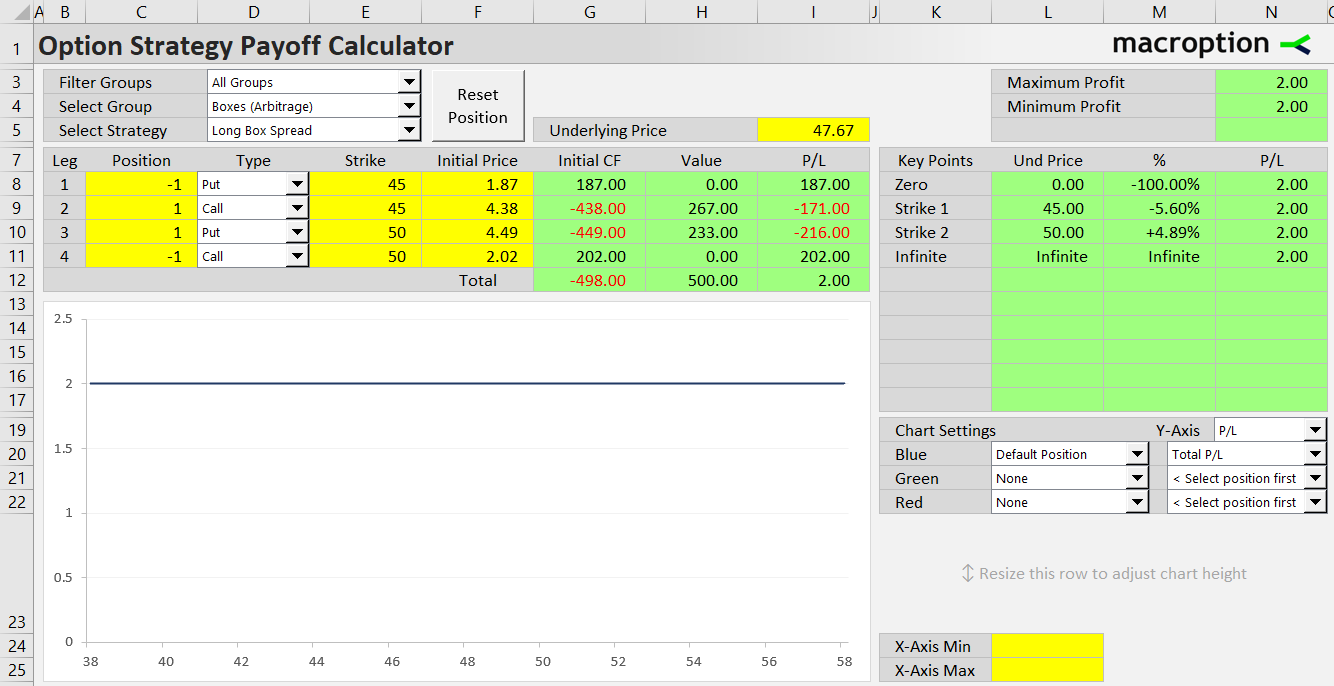Long box spread is an arbitrage option strategy with four legs. Because the payoff profiles of individual legs cancel each other, total outcome of the position is fixed (a small profit or a small loss).

Setup
Long box spread is a combination of two vertical spreads: a bull call spread and a bear put spread with identical strikes. It includes four options:
- Long call with lower strike
- Short call with higher strike
- Long put with higher strike
- Short put with lower strike
The long call strike must be the same as the short put strike (lower strike).
The long put strike must be the same as the short call strike (higher strike).
Example
For example, a long box spread can be created with the following transactions:
- Buy a call with 45 strike.
- Sell a call with 50 strike.
- Buy a put with 50 strike.
- Sell a put with 45 strike.
The two calls form a 45/50 bull call spread. The two puts form a 50/45 bear put spread.
Payoff
As long as the strikes match, the payoffs from the two vertical spreads cancel one another and the resulting total box spread payoff is constant – usually a very small profit or loss at any underlying price.

Why do the vertical spreads cancel one another?
The payoff from any vertical spread is constant below the lower strike and above the higher strike. It only varies between the strikes, but even there, the relationship between underlying price and profit or loss at expiration is always linear. Payoff from a bull call spread rises between the strikes, while bear put spread payoff declines. As a result, the combined profit or loss from the two vertical spreads (the entire box spread) is constant.
Order and Distance of Strikes
When opening a long box spread, the order of strikes matters. If it is the opposite (the long call and short put strike is higher than the short call and long put strike), the position is a short box spread, which has identical payoff profile (constant small profit or loss) but different cash flow.
The distance between the two strikes does not matter in terms of payoff profile (it is still constant), but it can also affect cash flow.
Cash Flow
Because it is composed of two debit vertical spreads, initial cash flow from opening a long box position is negative.
At expiration the long box spread has positive value, exactly equal to strike distance regardless of underlying price.
Long Box Spread as a Bond
In fact, the cash flow from a long box trade is similar to a zero coupon bond.
When the options are fairly priced, total net result from the trade should be a small profit corresponding to the interest earned on such bond.
Arbitrage
The main motivation for trading a box spread is arbitrage – making riskless profit if the options are mispriced.
However, what looks like sure profit on paper may turn out a loss in practice. There are several things to keep in mind when trading long box spreads for arbitrage:
Firstly, transaction costs from the four legs may be too high to make the arbitrage viable.
Secondly, the profit may only represent the riskless interest earned on the capital used to open the spread in the beginning (and often it is less). That cash is only coming back at expiration. Therefore, the time value of money and the trader's cost of financing must always be considered.
Thirdly, if the options are American, there is risk of early assignment.